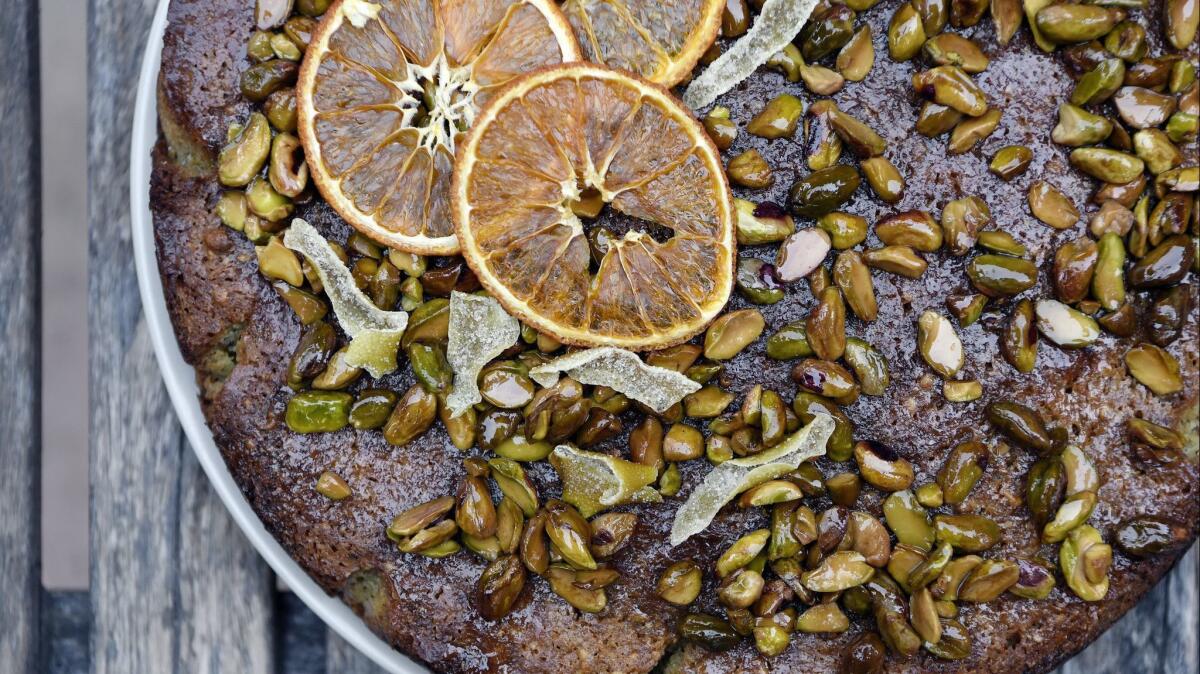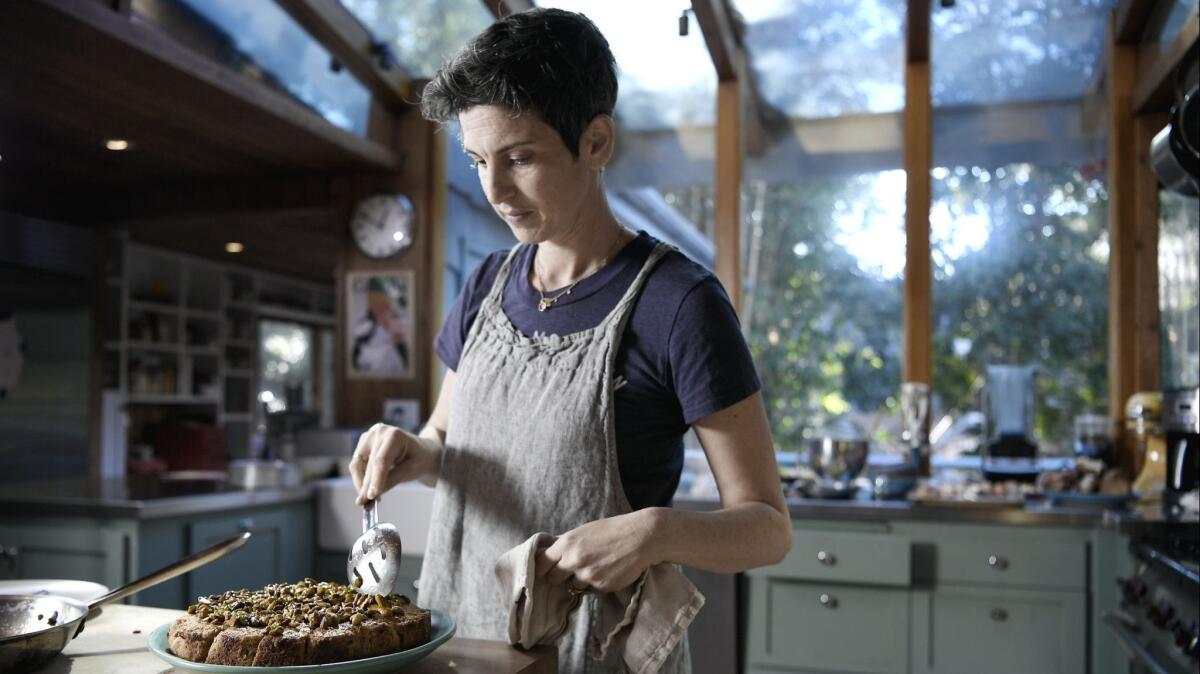Learning to bake with Huckleberry’s Zoe Nathan

- Share via
You can’t throw a baguette in L.A. without hitting a naturally leavened loaf these days, but 10 years ago when Zoe Nathan and her husband, Josh Loeb, opened Huckleberry, a cheery white-walled bakery on Wilshire Boulevard, news that Nathan, a Tartine Bakery alum, was launching a bread and pastry program in Santa Monica drew immediate crowds.
People came for the architecturally improbable stacks of maple bacon biscuits, fresh fruit crostatas, kouign-amann and prosciutto-Gruyère croissants, their cheese still warm from the oven. They waited an hour for blueberry-stained corn cake and ate chocolate chunk muffins for breakfast. The pastry case was cartoonish in its abundance, the smell of sourdough perfumed the restaurant, and inevitably, you ordered more than you intended. Nathan’s acuity for butter, sugar, flour and fruit was palpable in the first bite.
RELATED: Making your own nut flours »
Like everyone else in L.A., I showed up, stood in line and was enamored by the moreness of it all, so I worked up the courage to ask if I could stick around and learn in Nathan’s kitchen if I promised to keep my mouth shut and stay out of the way.
To my surprise, she said yes, gave me a spoon, pointed to a stockpot and instructed me to start skimming. I wedged myself in between the stove and the flattop and stood over that pot chasing globules of chicken fat for three hours before Nathan reappeared at my side.
She needed a baker, and while my experience amounted to a few loaves of no-knead bread in my Dutch oven at home, I was eager to learn, and more important, I was standing right in front of her. “I can’t teach passion,” she told me, “but I can teach anyone how to bake.” So after a one-day trial she hired me, and the next morning at 4 a.m. my apprenticeship began.
I cycled through the stations, mixing muffins and frying doughnuts before building layer cakes and troubleshooting buttercream. I learned how to laminate croissant dough and shape baguettes. I screwed up everything at least once, but Nathan had the grace not to fire me.
Baking at Huckleberry was a full-contact sport. We worked hard. We got burnt. The kitchen was bursting at the seams, churning out as many pastries and loaves as the ovens could muster. I loved the physicality but hated setting my alarm clock for 3 a.m., so after 15 months I left to find work that started after the sun came up.
It’s been nine years since I apprenticed in Nathan’s kitchen, but I still use the skills I learned on those groggy mornings every day when I cook at home. So on the eve of the restaurant’s 10th anniversary last month, I visited Nathan at her home in Santa Monica to talk about the lessons you can learn from baking cake.
Plan ahead

The golden rule of cooking from recipes is to read the recipe from top to bottom before you start cooking. Do the nuts need to be toasted (and cooled) before you grind them? Does the butter need to come to room temperature? Does the chicken need to brine overnight? Recipes are road maps, and if you read them in advance you can anticipate what’s to come and bypass any surprise left turns.
At Huckleberry, we weighed and labeled the next day’s ingredients at the end of each shift so that when we arrived the next morning at 4 a.m. we could just dump and stir until the caffeine kicked in. The fancy term for this type of organization is mise en place, which translates to everything in its place. At home, measuring out your ingredients before you pick up a knife or a whisk means you won’t forget a crucial ingredient like salt, which brings me to lesson No. 2.
Salt doesn’t mean salty
“Salt is a flavor enhancer,” Nathan says. “It’s not just to make things taste salty or taste like McDonald’s; it has a purpose.” A generous pinch of salt in your blueberry pie filling will make the finished product taste more like blueberry pie.
I learned this lesson the hard way at Huckleberry when I baked three tall and proud pumpkin teacakes and unknowingly had forgotten the salt. I watched Nathan take a bite and then toss them one by one into the trash. Of course she had me taste my mistake before it went in the garbage can, and what struck me most was how remarkably dull it was. Without salt, the sugar, the pumpkin and the spice had gone missing. It was as if the lights had been turned off.
Color is flavor

Recipe: Lemon-pistachio cake »
If there was a mantra of morning bake at Huckleberry, this was it. I can still hear Nathan’s voice, telling the new girl to put the scones back in the oven and repeating the phrase for the 100th time: “Color is flavor.”
You could turn to science to spell out why caramelization and the Maillard reaction make food taste better, but I prefer Nathan’s explanation. “I think of color as another ingredient,” she says. “When you toast something, you make it taste like more of what it is. Forgetting your color is like forgetting the salt.”
At L.A.’s only cookbook shop, a former fine-dining chef draws chefs, home cooks and crowds »
Cook with all your senses
One of the first mistakes I made at Huckleberry was asking how long the biscuits took to bake. I didn’t need a timer, I was told; the biscuits would bake until they were done. Instead of a stopwatch, I would have to use my eyes, ears, nose and hands to figure out when that was.
At Huckleberry the biscuits were studded with bacon and maple syrup, and their sweet, salty aroma was the first clue that they were almost done. The second was their appearance. First, the shoulders would slump as the butter yielded to the heat, and then the surface would freckle, slowly from the outside in, until each rounded top turned an amber hue. At this point we would pull them out of the oven just long enough to brush each biscuit with a lacquer of maple syrup and then continue to bake them until the amber gave way to a rich toffee brown.

“As I’ve gotten older I’ve become more of a spiritual person,” Nathan tells me, “but when I was younger, baking was my meditation, my religion, my everything. It was the only thing that made me present, and when you’re present, you’re seeing things, you’re hearing things, you’re a part of things. I guess I never understood why someone would turn that off. Does anyone really need a piece of cake? I was baking to get centered, to feel like myself.”
When you cook with your senses, you can hear the water boil and smell the butter browning. You can look for hot spots, feel for doneness, and most important, Nathan reminds me, taste for salt in your batter.
Relax

“People are scared of baking,” Nathan says, while scooping the last of her pale yellow batter into a well-worn cake pan. “There’s so much unnecessary pressure around food because you want it to look good. You have to follow the recipe, and then if you screw it up, it’s wrong.” What’s missing from the kitchen, she says, is playfulness.
So pile on too much frosting. See how tall you can stack the layer cake. Let go of the picture-perfect image and embrace the mess. Baking is not about getting the Instagram photo, it’s about creating joy.
“What’s the worst thing that’s going to happen? If it’s horrible, then you throw it away and drive to your local bakery and buy something sweet. That’s what we’re there for.”
More to Read
Eat your way across L.A.
Get our weekly Tasting Notes newsletter for reviews, news and more.
You may occasionally receive promotional content from the Los Angeles Times.







